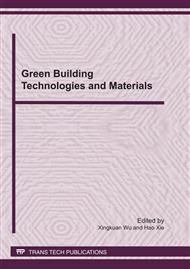p.170
p.175
p.179
p.185
p.192
p.198
p.205
p.210
p.216
Studies on Ecological Design Strategies of Greening of Building External Wall
Abstract:
Building energy conservation has become the worldwide tendency since the mid-1970s. The Theory of Sustainable Development raised in 1990s as well as the deterioration of ecological environment made the building energy conservation became the international focus all over the world. China is a country with high energy consumption and large population and the percentage of its building energy consumption has reached about 25% on total energy consumption. The energy conservation condition of building external wall is one of the direct influencing factors of thermal comfort of indoor environment. However, greening is a kind of natural sunshade of the nature. The key to the study is how to improve the temperature of building walls and thermal comfort of indoor environment by the way of greening sunshade of external walls.
Info:
Periodical:
Pages:
192-197
Citation:
Online since:
April 2011
Price:
Сopyright:
© 2011 Trans Tech Publications Ltd. All Rights Reserved
Share:
Citation:


